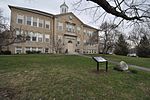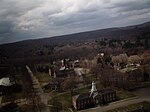March Route of Rochambeau's Army: Reservoir Road
American Revolution on the National Register of Historic PlacesConnecticut Registered Historic Place stubsConnecticut in the American RevolutionHistoric districts in Fairfield County, ConnecticutHistoric places on the Washington–Rochambeau Revolutionary Route ... and 4 more
NRHP infobox with nocatNational Register of Historic Places in Fairfield County, ConnecticutNewtown, ConnecticutRoads on the National Register of Historic Places in Connecticut

March Route of Rochambeau's Army: Reservoir Road is a historic site in Newtown, Connecticut. It was listed on the National Register of Historic Places in 2003.It is along the march route taken by French commander Rochambeau's troops in 1781. The listed site is less than 1 acre (0.40 ha) in area, and comprises a section of Reservoir Road running between stone walls, which is believed to be the roadway taken by Rochambeau's army. It is an undeveloped property.It's one of multiple properties whose possible listing on the National Register was covered in a 2001 MPS study.
Excerpt from the Wikipedia article March Route of Rochambeau's Army: Reservoir Road (License: CC BY-SA 3.0, Authors, Images).March Route of Rochambeau's Army: Reservoir Road
Reservoir Road,
Geographical coordinates (GPS) Address Nearby Places Show on map
Geographical coordinates (GPS)
| Latitude | Longitude |
|---|---|
| N 41.413333333333 ° | E -73.323055555556 ° |
Address
Reservoir Road 10
06470 (Newtown)
Connecticut, United States
Open on Google Maps










